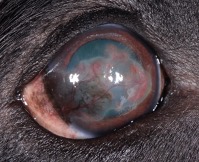- All patients with pannus require lifelong treatment
- Pannus is not typically a painful disease
- Uncontrolled pannus may lead to vision loss
 Pannus, or chronic superficial keratitis, is a progressive inflammatory immune mediated disease of the cornea (the transparent, domed surface of the eye). Clinical signs of pannus typically include progressive vascularization, brown pigment deposition, and haziness of the cornea. If not diagnosed and treated correctly, this disease can lead to blindness. Diligent treatment of the disease will preserve vision in the vast majority of dogs.
Pannus, or chronic superficial keratitis, is a progressive inflammatory immune mediated disease of the cornea (the transparent, domed surface of the eye). Clinical signs of pannus typically include progressive vascularization, brown pigment deposition, and haziness of the cornea. If not diagnosed and treated correctly, this disease can lead to blindness. Diligent treatment of the disease will preserve vision in the vast majority of dogs.
Causes of pannus are poorly defined, however there are some known contributing factors:
- Genetics: certain breeds of dogs such as German shepherds, greyhounds, and border collies are predisposed to developing this disease suggesting an inherited component
- UV exposure: due to the high elevation in Colorado our pets experience increased UV exposure which can exacerbate this disease
- Immune system: pannus is thought to have an immune-mediated component in which the body directs an inappropriate immune response against the tissues of the cornea
Treatment for pannus typically consists of topical steroids and immunosuppressive medications. Frequency of the medications depends on the severity of disease. In cases that are particularly difficult to control, injections of slow release steroids under the pink tissue surrounding the eyeball may be recommended. Rechecks are recommended every few months initially in order to ensure adequate control of the disease on the current medication regimen. All patients with pannus require life-long treatment.
Due to the potential for UV light to worsen pannus, it is recommended that pets remain indoors between the peak UV hours of 10 a.m. to 3 p.m. Additionally, UV protective eyewear is recommended when pets are outside.